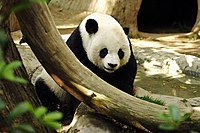
Photo from wikipedia
Inferring the processes underlying spatial patterns of genomic variation is fundamental to understand how organisms interact with landscape heterogeneity and to identify the factors determining species distributional shifts. Here, we… Click to show full abstract
Inferring the processes underlying spatial patterns of genomic variation is fundamental to understand how organisms interact with landscape heterogeneity and to identify the factors determining species distributional shifts. Here, we use genomic data (restriction site‐associated DNA sequencing) to test biologically informed models representing historical and contemporary demographic scenarios of population connectivity for the Iberian cross‐backed grasshopper Dociostaurus hispanicus, a species with a narrow distribution that currently forms highly fragmented populations. All models incorporated biological aspects of the focal taxon that could hypothetically impact its geographical patterns of genomic variation, including (a) spatial configuration of impassable barriers to dispersal defined by topographic landscapes not occupied by the species; (b) distributional shifts resulting from the interaction between the species bioclimatic envelope and Pleistocene glacial cycles; and (c) contemporary distribution of suitable habitats after extensive land clearing for agriculture. Spatiotemporally explicit simulations under different scenarios considering these aspects and statistical evaluation of competing models within an Approximate Bayesian Computation framework supported spatial configuration of topographic barriers to dispersal and human‐driven habitat fragmentation as the main factors explaining the geographical distribution of genomic variation in the species, with no apparent impact of hypothetical distributional shifts linked to Pleistocene climatic oscillations. Collectively, this study supports that both historical (i.e., topographic barriers) and contemporary (i.e., anthropogenic habitat fragmentation) aspects of landscape composition have shaped major axes of genomic variation in the studied species and emphasizes the potential of model‐based approaches to gain insights into the temporal scale at which different processes impact the demography of natural populations.
Journal Title: Molecular Ecology
Year Published: 2019
Link to full text (if available)
Share on Social Media: Sign Up to like & get
recommendations!